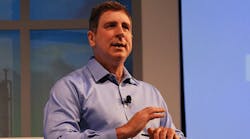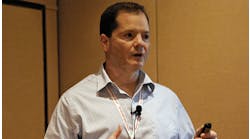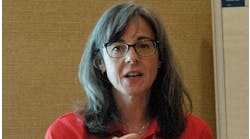“Each step drives better performance, improves safety, increases production yield and boosts reliability with better asset insights, ensuring that personnel working within standard operating procedures deliver flawless operations.” Honeywell’s Jason Urso explained how the company’s latest digital tools are designed to help workers perform at their very best.
Consider an offshore oil-rig platform being built today. Or, more specifically, consider the workforce that would call that platform home for weeks at a time. They don’t really want to live there, removed from society in a wave-battered, potentially dangerous setting. And nobody wants to build an oil-rig platform with living quarters that will soon be unnecessary.
Honeywell CTO Jason Urso uses that scenario as way to demonstrate the modern mindset about industrial automation. Or, specifically in Honeywell parlance, Industrial Autonomous, how they label their mission to implement autonomous operations wherever feasible in order to capitalize on emerging digital tools to enable us to work more efficiently. If you don’t need to put humans on an oil rig…you don’t.
But it’s not mainly about removing humans from industrial processes, Urso stressed during his technology overview at this week’s Honeywell Users Group Americas conference in Orlando, Fla. The broader goal of Industrial Autonomous is to free workforces so that they may best use their human capabilities to become what he described as “elite athletes within their disciplines.”
Game on.
During this rapid-fire overview on a stage that looked more spaceship than conference hall, Urso demonstrated the high level of automation and integration needed for sustainable efficiency and productivity in today’s process-control environment; from digitized, on-premise migrations to the latest resilient Experion Process Knowledge System (PKS) functionality. He introduced the next-gen technology to improve plant sustainability, including energy storage and hydrogen-production solutions alongside machine learning capabilities to enhance human reliability, and digital twins to better visualize and optimize operations.
“A more digital world,” he described it. More remote. More reliant on technology to be more productive while increasing collaboration. System life has become infinite, he boasted, and it is able to evolve through time and run on the latest microprocessor technologies.
Four stages of autonomous maturity
It’s a lofty claim…a big bet…backed by that broader belief in Industrial Autonomous, which Urso explained is built around a four-step maturity model:
- Control & Optimize: The goal is to automate processes with sustained operation at peak performance. Plants with the best processes have fewer slowdowns and shutdowns, the CTO noted, before recognizing that it is difficult to sustain optimum performance levels since process equipment is in a constant state of degradation. Autonomous initiatives can overcome that challenge.
- Intelligent Assets: Predictive asset performance and reliability to reduce unplanned losses is a top priority. As such, smart automated asset-performance management is critical to Industrial Autonomous.
- Expert People: Every worker should be enabled to perform at an elite level courtesy of innovations like intelligent wearables to enable hands-free communication control centers. An overarching mission should be to augment the intelligence of everyone in every process.
- Remote Operation: Monitor, control and service remotely. Work more efficiently with suppliers and use common resources to resolve challenges at different enterprise locations.
“Industrial Autonomous is real,” stressed Urso. “People are doing this today. Each step drives better performance, improves safety, increases production yield and boosts reliability with better asset insights, ensuring that personnel working within standard operating procedures deliver flawless operations.”
So what tools are at play here? Plenty, as Urso explained with the enthusiasm of a kid opening presents on Christmas morning. First is Honeywell Forge Plant-Wide Optimizer, which recognizes individual models within each process area and finds intersection points between those models to drive optimizations, whether at one asset, across a plant, or as an enterprise-wide solution.
Next is Honeywell Forge Asset Performance Management for Industrial, which operates on-premise or in the cloud to connect in real time assets to enable the visualization of asset-performance KPIs. “To better understand what you have and how it is performing,” he summarized, highlighting how this knowledge-management tool welcomes the addition of existing operational smarts into the system to, ultimately, inform artificial intelligence and machine-learning elements to further refine monitoring capabilities.
The Honeywell Versatilis Equipment Health tool is an Internet of Things transmitter that easily, remotely monitors vibration, acoustic signatures and surface temperatures of assets without the need to send technicians out on wasteful inspection rounds. And then there is the Honeywell Versatilis Instrument Configuration & Calibration tool, which modernizes current (antiquated) calibration practices; think Bluetooth communication with an iPad, rather than a clunky, dedicated handheld device.
The goal of this journey, repeated Urso throughout his presentation, is infinite longevity, infinite reliability of industrial systems—true Industrial Autonomous operations that not only optimize processes but also provide pathways to sustainability.
This journey entails a drive toward more optimization in control, more visibility into asset performance, more teams outfitted with more products and processes that simplify their jobs and enable them to seamlessly operate in an increasingly mobile, remote manner.
“We are changing the whole way of interacting with and visualizing systems,” said the CTO. And it is, truly, a journey—a long one, considering Honeywell’s rich legacy in this space—assisted by tools and technologies introduced in this presentation. Professionals embarking on this journey are digitally evolving into, as Urso calls them, elite industrial athletes.
And our pace is quickening.
The editors of Control, Control Design and Smart Industry are reporting live from 2022 Honeywell Users Group in Orlando, Florida, to bring you the latest news and insights from the event. When the event comes to a close, the best, most important coverage will be compiled into a report by the editors.
Register now to pre-order the report and be among the first to receive it in your inbox.





